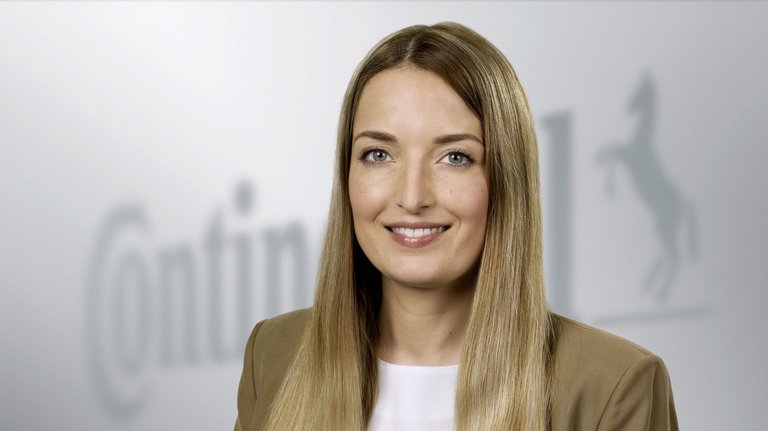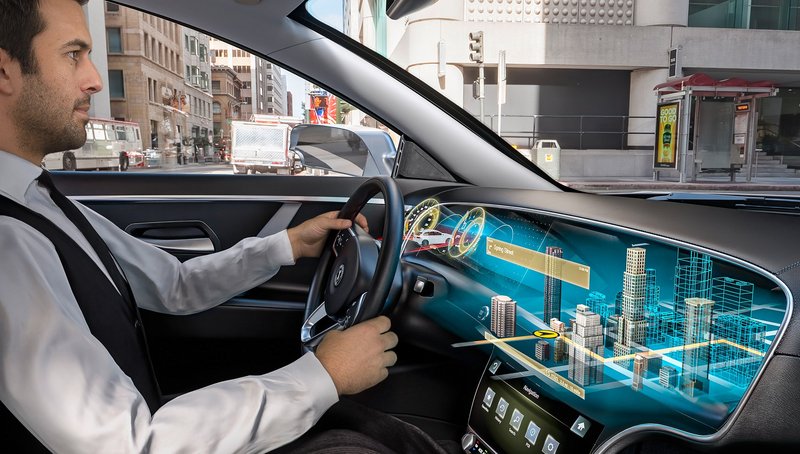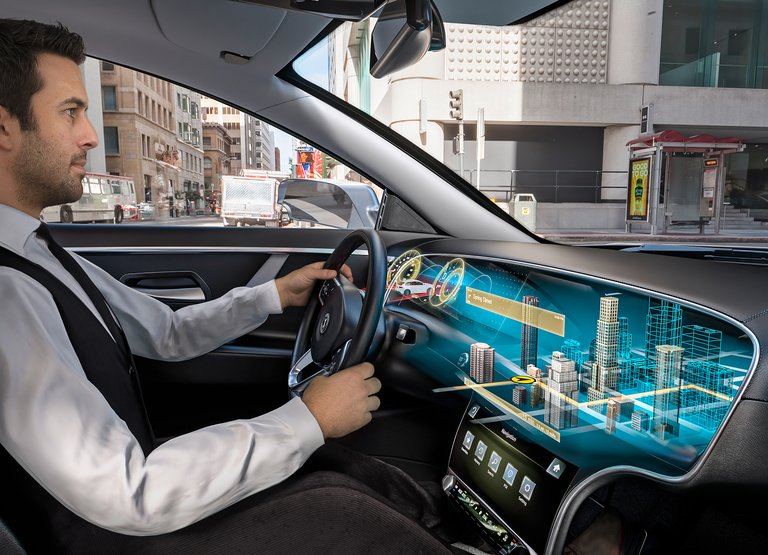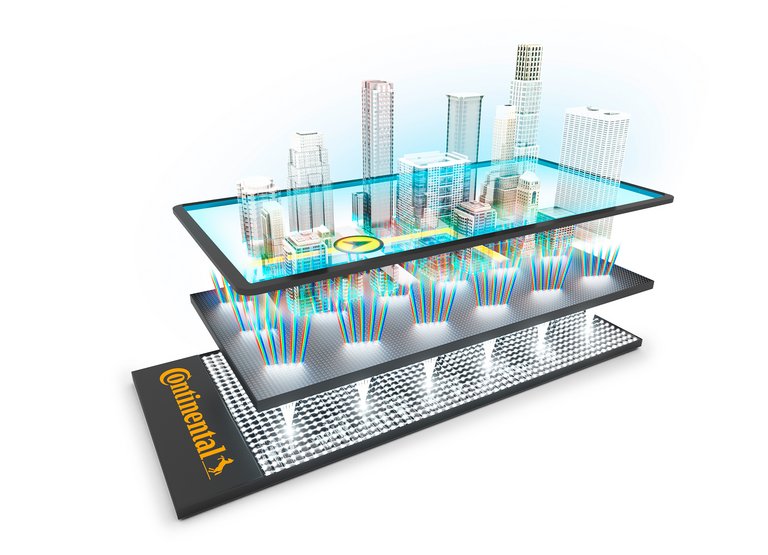Continental and Leia´s new 3D Lightfield Display bring the third dimension into Automotive vehicles
- Innovative Lightfield technology generates an unprecedented 3D experience for all vehicle passengers without special eyewear
- Comprehensive display technology and content platform for increased safety and comfort demands within the vehicle
- Continental works together with Silicon Valley company Leia Inc.
Babenhausen (Germany), June 11, 2019. A stop-sign, shining red hovers in front of the screen. Rows of houses rise out of the navigation system. The vehicle manufacturer’s logo rotates in the air in front of the dashboard. With these kinds of three-dimensional effects, Continental aims to revolutionize the way displays are configured in automotive vehicles. The technology company is currently developing an innovative cockpit solution, the Natural 3D Lightfield Instrument Cluster, in cooperation with Silicon Valley company Leia Inc. that will bring the third dimension into upcoming automotive vehicles, with unprecedented quality. Lightfield displays are the next generation of medium allowing not only the comfortable perception of 3D depth, but also the rendering of highlights, sparkles and other complex light effects. The technology enables information to be safely presented to the driver in real-time, allowing the driver´s interaction with the vehicle to become more comfortable and intuitive. It also allows passengers in the front and back seats to share the 3D experience with the driver.
“A new dimension of comfort and safety”
The new Lightfield cockpit is an evolutionary step in the design of the human-machine interaction within automotive vehicles. “One of today’s greatest challenges in the automotive industry is to develop intelligent concepts for the human-machine interaction. To create solutions that enhance the driver experience and allow the driver to simply and effectively interact with the vehicle without becoming distracted from the road”, explains Dr. Frank Rabe, head of business unit Instrumentation & Driver HMI at Continental. “The new Lightfield display does not just bring the third dimension of the highest quality into the vehicle - the innovative technology also creates a new dimension of comfort and safety. In addition, our solution provides every vehicle manufacturer the possibility to enhance the driver experience for their customers and to differentiate themselves from competitors thanks to customized scopes for design.” The new system is said to go into series production by 2022.
On the way to automated driving, there will be more opportunities for the driver to engage in other activities such as video calling, internet browsing or watching shows and movies. “The car is clearly the next frontier for Mobile” says David Fattal, Leia Inc. co-founder and CEO. “To us it’s a bigger, more immersive version of a smartphone with full 3D awareness of its environment. It’s a logical place to deploy our growing Lightfield ecosystem of immersive gaming, video streaming, social sharing, or even e-commerce.”
Visualizing content on a wide display specially designed for in-car visual comfort will be much more refined and enjoyable than using one´s smartphone. It will also offer the opportunity to leverage internal or external camera systems for video calling or augmented reality functions, a feature that the partnership intends to exploit.
3D Lightfield content can be seen by everyone in the vehicle
Leia´s Lightfield technology used for Continental’s natural 3D display does not need a head-tracker camera – a practical and, of course, cost-efficient advantage. Moreover, passengers in the front and back seats can also clearly see the same 3D image from their seated positions – something that was previously not possible. Furthermore, there is yet another leap in quality of the new system in comparison with previous 3D-methods. The 3D-image produced by the Lightfield display is made up of a total of eight perspectives of the same object that subtly vary according to the point-of-view.
A glance at the Lightfield display "wanders" when changing the angle from every passenger position – in this way an exceptional and unique natural display of information is possible. “Thanks to our Lightfield display, we achieve a completely new level of 3D-image display”, says Kai Hohmann, Product Manager, Display Solutions at Continental. “The newly developed light conductor with nanostructures is essential for the quality. We are not refracting the light, we are bending and guiding it precisely to attain the optimal 3D-effect needed. Only via this technology it is possible to meet the ever-increasing requirements for comfort and safety within the interior of the vehicle.”
Continental is now adapting Leia’s technology for use in automotive vehicles. Until recently, either parallax barriers or lenticular techniques were used to achieve a glasses-free 3D effect. They achieve a 3D effect through a special method of blocking or refracting light. Parallax barrier systems, in particular, offer only a single user application by requiring a head tracker system to adjust the 3D views towards the observer´s exact head position. Furthermore, in a similar way to a filter, they can negatively impact the perceived image quality and effectiveness of the light output in a multi-user application designed for the driver, co-driver and rear passenger. For the automotive industry, the highest quality especially for displaying information is imperative. Continental’s new 3D Lightfield application comprising Leia’s DLB™ (Diffractive Lightfield Backlighting) technology offers the next level above conventional 3D displays and enables a crystal-clear screen, even when sunlight is shining directly onto it.
Use of nanotechnology from Silicon Valley
The quality of the resolution as well as the look and feel of the Natural 3D Lightfield Instrument Cluster is clearly higher than that of conventional 3D-displays. This has been achieved thanks to Diffractive Lightfield Backlighting, which is a newly developed technology, whereby light conductors with diffraction grating and nanostructures create a precise diffraction of light under the display panel – thus creating a natural 3D-effect. This light-field module can be easily integrated into commercially available displays.
“Leia has developed cutting-edge nano manufacturing process suitable for large scale and mass volume, which allowed the commercialization of its technology last year. We have bridged advanced lithography onto large-scale substrate with high yield and competitive cost, leveraging experience rooted from HP and continued in-house development over the past five years. Now we will bring this unique capability to even larger scale while complying with automotive safety standards and cost competitiveness”, says Zhen Peng, Leia Inc.’s co-founder and CTO. Leia’s Lightfield technology made its commercial debut in the U.S. through smartphone displays with AT&T and Verizon. Consumers are already able to enjoy gaming, movies, augmented reality and the sharing of pictures in unprecedented 3D quality. The Lightfield experience consists of the Lightfield display and a comprehensive amount of automotive use case applications which will be provided by Continental.
Automotive content and Lightfield SDK
The partnership goes beyond hardware and the two companies are also collaborating on content creation and developer ecosystem support. Leia currently offers a creative toolkit to convert or create content to the Lightfield format, with automatic settings to ensure visual comfort. There are many possible applications for the new display’s Lightfield projection. Warnings from the driver assistant system will be illustrated in 3D; directions from the navigation system can be even more clearly presented; graphic display of the parking assistant – such as the 360-degree bird view assistant - will become a real eye-catcher in 3D, and the greeting by the vehicle system can be enhanced using 3D-animations so that the manufacturers logo rotates in 3D. “In this case it is important to note that the 3D-animations of our new display do not fly through the car, like they would in the cinema”, Hohmann emphasizes. “We work with the graphic depth to the rear and allow all 3D-objects a maximum of five centimeters out of the picture. This is much more relaxed for the eye and will ensure the driver does not become distracted”. And of course, for the full 3D-effect, no glasses are required. Every projection can be seen by the naked eye.
The collaboration plans to leverage Continental’s expertise in automotive information systems and sensors to augment Leia’s content platform LeiaLoft™ and enables car manufacturers and third-party developers to easily create “holographic” apps for the car of tomorrow. This Automotive Software Development Kit (SDK) will give developers access to the car’s interior and exterior environment in full 3D and enable a host of applications from holographic navigation, park assist or augmented reality on the digital cluster or central information display.
“We are thrilled to tailor our Lightfield platform to automotive. By leveraging specific sensors’ data (Lidar, cameras) we will deliver premium applications as well as bring the mobile ecosystem into the car to create an enhanced driver’s experience.”, says Pierre-Emmanuel Evreux, Leia Inc. co-founder and president.
The collaboration with Leia Inc. was initiated by co-pace, Continental’s start-up organization. Through the Corporate Venture Capital team of Continental, the commitment was further cemented with a minority stake investment. Co-pace enables partnerships of innovative external start-up companies with Continental.
Continental presents the Natural 3D Instrument Cluster for the first time at the CES Asia in Shanghai. Visitors can find Continental from June 11 to 13, 2019 in Hall N5, Booth #5702 & #5716 at the Shanghai New International Exhibition Center.

Alena Liebram
Media Spokesperson Automotive Operations & Technology and Aftermarket
AUMOVIO


